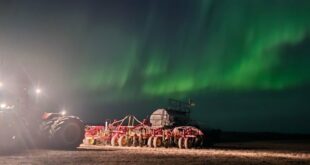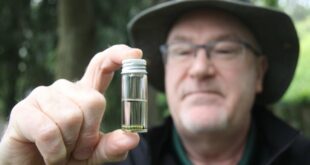Pilot project also aimed at reducing carbon and creating wildlife habitat.

A watershed group in eastern P.E.I. is experimenting with a new mini-wetland that will filter pollutants, fertilizer and pesticides from water trickling out of the neighbouring farm field.
The new vegetated ditch will also absorb carbon and create wildlife habitat.
The Souris and Area Branch of the P.E.I. Wildlife Federation is one of the partners in the project.
“It’s going to be an elongated ditch, wider than a normal drainage ditch would be,” said project manager Jake MacKinnon.
“The idea is that it’ll hold water, and encourage it to stagnate, and any of the nutrients contained in the water will help feed what should turn into, hopefully, a blossoming wetland site.
“It should help to filter any kind of runoff coming off the agricultural field nearby, as well as creating a lot of habitat for birds and vertebrates, and amphibians.”

Easier to build
The Souris watershed group has worked with local farmers to add other wetlands as part of the Living Labs project.
But MacKinnon says the mini-wetland is a new concept.
“These sites were designed as a more low-impact version of a full-size constructed wetland,” MacKinnon said.
“The idea is that it takes up a lot less footprint in the field, so it’s much easier to implement. You could have a number of wider-spread smaller sites compared to one or two larger ones.

It took the watershed group several days to build the new mini-wetland.
“The biggest factors for us in this site were a low grade, which meant we wouldn’t catch too much runoff. Because this is an experimental site, we want to have a fairly controlled input,” MacKinnon said.
“We also wanted to have it near a watercourse just to make sure that — assuming it works — it will have a beneficial impact on the local ecosystem as well.”

MacKinnon said the researchers will take samples along the new mini-wetland every two weeks and test them for nitrogen levels.
He said the field next to the mini-wetland will have potatoes planted in it next season, “which is where we tend to see the greatest volume of nitrates. That should give us a pretty good sample year to see very quickly what kind of impact this ditch is going to make.”
MacKinnon said reducing greenhouse gas emissions, by storing carbon in the mini-wetland, is another goal of the pilot.
“Actually, sequestering carbon is one of the main goals with this project,” he said. “Wetlands are one of the strongest carbon sinks that we have available to us.”
Climate change
A research scientist with Agriculture and Agri-Food Canada said the idea for the project comes from the United States, where they are widening existing ditches and planting vegetation to slow down the flow of the water to reduce pollutants.
Audrey Murray said P.E.I. doesn’t have the same kinds of ditches, so they are building wetlands on the side of farm properties instead.
“Wetlands are almost the perfect natural water treatment device,” Murray said.
“Our hope is that we’ll be able to basically increase the percentage of wetland in agricultural ecosystems, [and[take some of the agricultural land back for wetland.”

Murray said the new mini-wetlands will also guard against potential threats from changing weather patterns.
“One of the biggest challenges, especially for P.E.I., that we’re going to face with climate change is going to be extreme rainfall,” she said.
“So in those extreme rainfall events, instead of all of the water reaching the waterway, the river, the water that’s being held in the wetland will reach the river later. So the big storm surge in the river will be levelled off, and prevent flooding of that river.”
ABOUT THE AUTHOR
Nancy Russell has been a reporter with CBC since 1987, in Whitehorse, Winnipeg, Toronto and Charlottetown. When not on the job, she spends her time on the water or in the gym rowing, or walking her dog. Nancy.Russell@cbc.ca
*****
Credit belongs to : www.cbc.ca
 Atin Ito First Filipino Community Newspaper in Ontario
Atin Ito First Filipino Community Newspaper in Ontario







